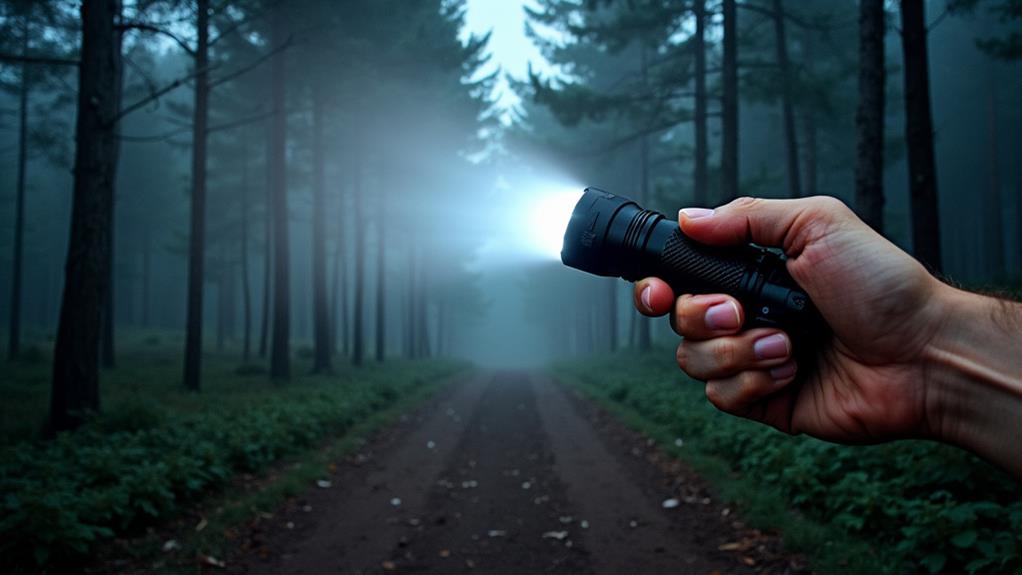Why Do Soldiers Use Red Flashlights?
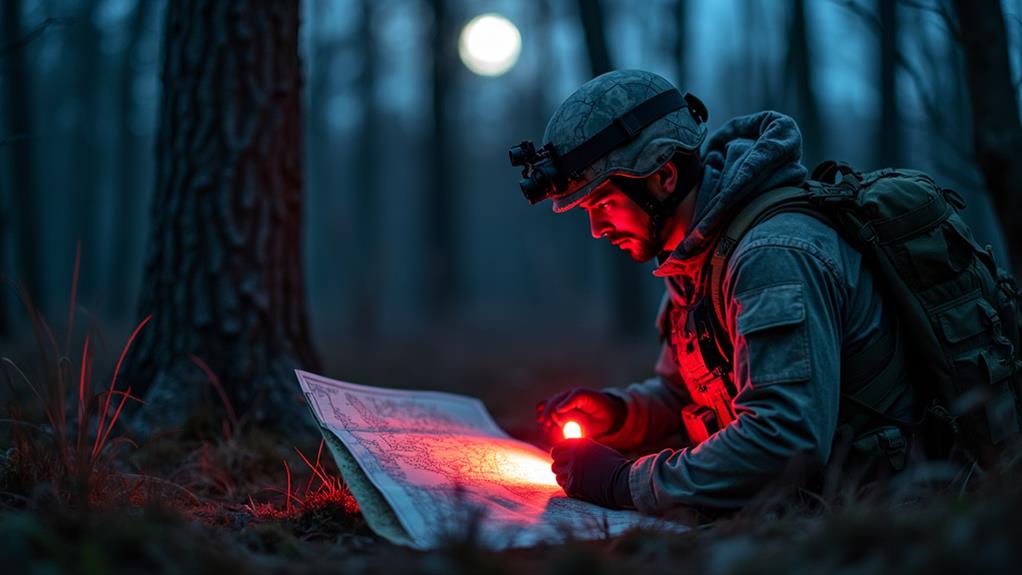
Soldiers often use red flashlights during nighttime missions for strategic reasons. Red light helps preserve night vision, which is crucial for staying alert and unnoticed. It also reduces the likelihood of detection by the enemy, providing a tactical advantage. Additionally, red light has other benefits that support essential operations and survival. Curious about what these could be?
Improve Night Vision
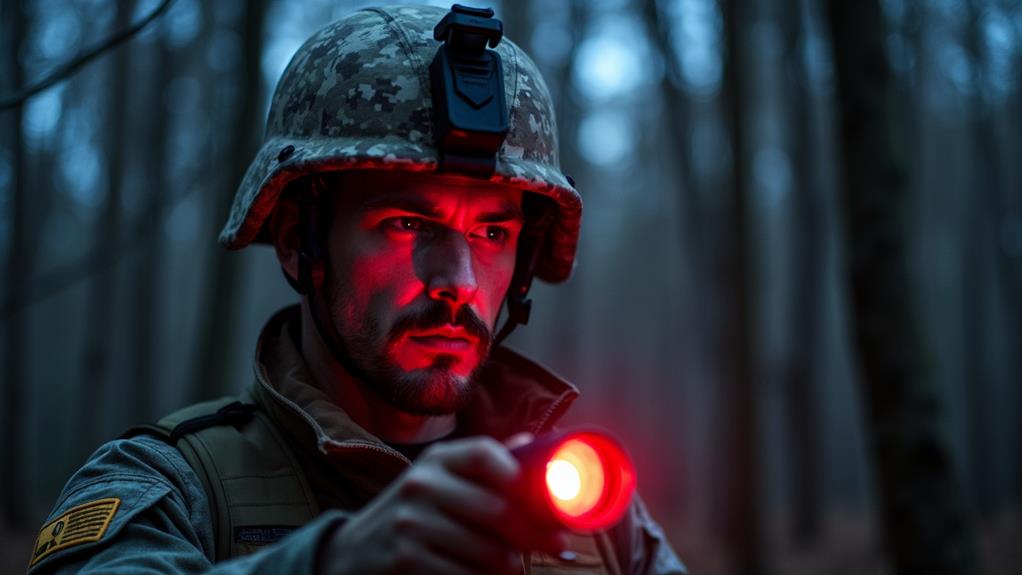
Using red flashlights significantly enhances night vision for soldiers. Red light helps preserve night vision by minimizing retinal stimulation, allowing users to see in the dark without compromising their ability to adapt to low-light conditions. Human eyes are less sensitive to red light, reducing the risk of retinal damage compared to white or blue light sources.
Red light improves dark adaptation, maintaining visibility during nighttime operations without the glare associated with other light colors. This advantage is particularly crucial when transitioning between bright and dark environments. Red light minimizes disruption to natural night vision, making these transitions seamless.
Additionally, the longer wavelengths of red light reduce scattering and glare, essential for effective navigation and task performance in dark settings. When used with night vision equipment, a red flashlight becomes an invaluable tool, ensuring efficient and safe operation in low-light scenarios. This helps maintain situational awareness and responsiveness in challenging environments.
Reduced Visibility
When on a mission, using a red flashlight enhances stealth by emitting light that is less detectable from a distance. This reduced visibility keeps you safer, as enemies are less likely to notice you. Red light preserves your tactical advantage, allowing you to navigate and communicate without compromising your position.
Enhances Stealth Operations
In the realm of nighttime missions, red flashlights are crucial for augmenting stealth operations due to their low visibility. Military personnel depend on red light to maintain discretion, as it is less detectable from a distance. This minimizes light pollution, enabling soldiers to maneuver and communicate without drawing unwanted attention.
Red light has a shorter range compared to white light, making it ideal for covert operations. When navigating through dark terrain, the limited illumination ensures you can see your immediate surroundings without revealing your position to potential threats. This controlled visibility is essential for staying concealed and maintaining the element of surprise.
Moreover, humans are less sensitive to red light, which further reduces the risk of detection by nearby enemies. By utilizing red flashlights, you can perform necessary tasks like reading maps or signaling to your team without compromising your safety. This practice not only keeps you hidden but also enhances the overall effectiveness of your mission.
Ultimately, employing red light in nighttime operations supports your stealth by providing just enough illumination to operate effectively while minimizing the chances of being spotted. This strategic use of red light is a significant factor in the success of military covert missions.
Limits Detection Range
Red flashlights are crucial for nighttime operations, especially during stealth missions. The red light emits wavelengths that are less visible to the human eye, significantly reducing the risk of being detected by enemies. This limited visibility is essential for maintaining a low profile.
Using a red light flashlight allows you to navigate and communicate in the dark without revealing your position. Unlike white light, red light does not travel as far, enabling discreet movement and signaling during covert operations. This is why the military frequently employs red light for such purposes.
Human eyes are less sensitive to red light, which helps ensure you remain undetected, even in close proximity to adversaries. This makes red light invaluable for covert operations. The reduced visibility of red light serves as an effective signaling tool, providing necessary illumination while minimizing the risk of detection.
Preserves Tactical Advantage
Strategic invisibility is a key advantage of using red flashlights in military operations. In the field, maintaining a low profile is essential. Red light emits a softer glow that doesn't travel as far as white light, allowing for navigation and communication without revealing your position. This reduced visibility is crucial for preserving tactical advantage.
Your eyes are less sensitive to red light, enabling effective vision without compromising night vision. This is especially beneficial during nighttime operations where even minimal illumination could expose your location to adversaries. Using red light enhances your stealth capabilities, ensuring you remain undetected while executing critical missions.
The limited range of red light provides sufficient illumination for tasks without drawing unwanted attention, maintaining operational security by minimizing your light signature. This makes it harder for enemy forces or surveillance systems to detect you. Essentially, red flashlights enable covert movements and tasks, giving you a significant edge in maintaining tactical advantage in various military scenarios.
Stealth Communication
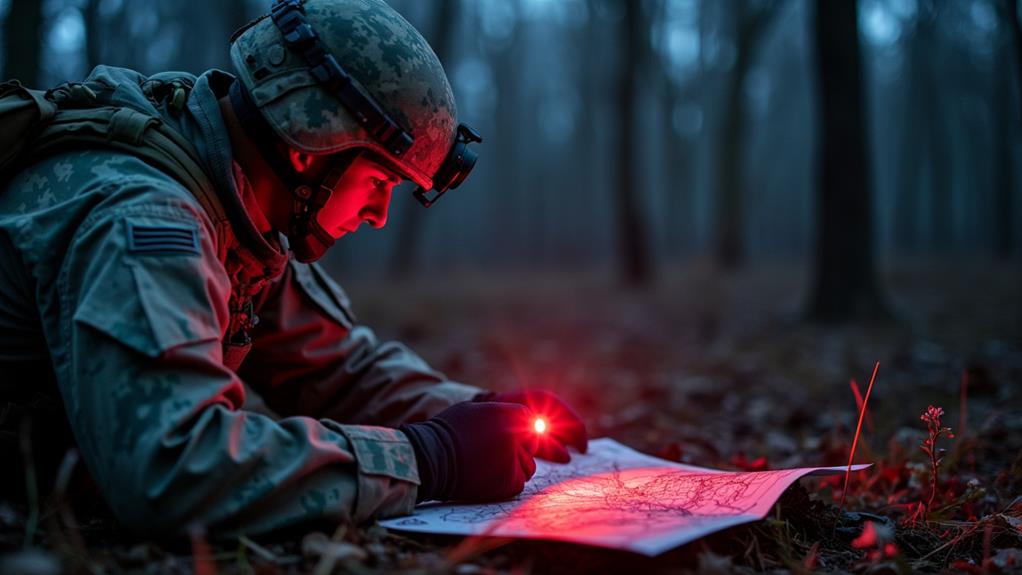
During nighttime operations, soldiers use red flashlights for discreet communication, an essential aspect of operational security. Red light is less visible from a distance compared to white or blue light, allowing for communication without revealing one's position. This low-intensity light significantly reduces the risk of enemy detection, helping to maintain the element of surprise.
In military settings, red light is standardized for signaling among personnel. This ensures quick recognition of allies during high-stress situations. Red flashlights facilitate communication in the dark, preserving night vision while conveying important information during patrols or stake-outs.
Tactical training underscores the importance of red light for stealth communication. Using red light allows the sharing of crucial details without compromising location, which is vital for operational security and safety. Efficient and discreet communication in the dark is a skill developed through rigorous training, highlighting the critical role of red flashlights in military operations. Your red flashlight is more than just a tool—it's a lifeline.
Signal Identification
In the field, quick recognition of allies can be a matter of life and death, and red flashlights make this possible. These lights enhance communication efficiency by providing a discreet signaling method that does not compromise your position. In high-stress situations, this critical advantage can mean the difference between survival and disaster.
Quick Ally Recognition
In the chaos of combat, quick ally recognition is crucial for military personnel. Red light serves as an important identifier, enabling soldiers to swiftly and accurately recognize each other. In high-stress environments, confusion about who is on your side can be detrimental. Red light allows soldiers to signal each other without exposing their positions to the enemy, thus maintaining operational stealth.
Red light is compatible with night vision devices, ensuring that team members can see each other clearly without compromising their night vision. This makes ally recognition not only possible but efficient. By reducing the risk of friendly fire incidents, red light provides a clear visual distinction between allies and adversaries, especially during low-visibility situations like night patrols or stake-outs.
Furthermore, the discreet nature of red light lowers the chance of detection from a distance, allowing soldiers to remain hidden while still communicating effectively. Thus, using red light in the field ensures quick and safe recognition of allies, enhancing overall mission success and keeping everyone coordinated.
Enhanced Communication Efficiency
Effective communication is crucial in military operations, and red light significantly enhances signal identification efficiency. During patrols or stake-outs, conveying information discreetly without compromising your position is essential. Red light acts as a vital identity marker, allowing team members to quickly recognize each other in high-stress situations. This rapid identification can be life-saving, as distinguishing friend from foe is critical.
Using red light for communication reduces the risk of revealing your position to adversaries. Its lower visibility from a distance helps maintain stealth, a significant advantage in military operations. Additionally, red light doesn't disrupt night vision, enabling you to stay alert and aware of your surroundings while still effectively communicating with your team.
Non-verbal communication becomes more efficient with red light. You can signal your squad silently, which is invaluable when silence is necessary. This seamless integration into tactical scenarios ensures that you can identify allies, convey critical information, and maintain operational efficiency without drawing unwanted attention.
Critical Survival Advantage
Building on the importance of improved communication efficiency, the red flashlight provides a critical survival advantage through effective signal identification. In the chaos of nighttime operations, the ability to quickly and accurately identify allies can mean the difference between life and death. Red light serves as a significant identity indicator, ensuring soldiers can distinguish friendly forces from potential threats with minimal risk of confusion.
Using red light for signaling has several key benefits:
- Minimized Visibility: Red light reduces the likelihood of detection by enemies, maintaining operational security while still offering the necessary illumination for communication.
- Enhanced Communication: In tactical scenarios, red light allows soldiers to relay vital information discreetly, preserving their positions and enhancing overall operational efficiency.
- Quick Recognition: A red flashlight helps soldiers quickly identify each other, facilitating coordinated actions and improving survival chances in dynamic environments.
These advantages ensure that the red flashlight remains an indispensable tool in military operations, offering both security and efficiency.
Bug and Wildlife Repellant
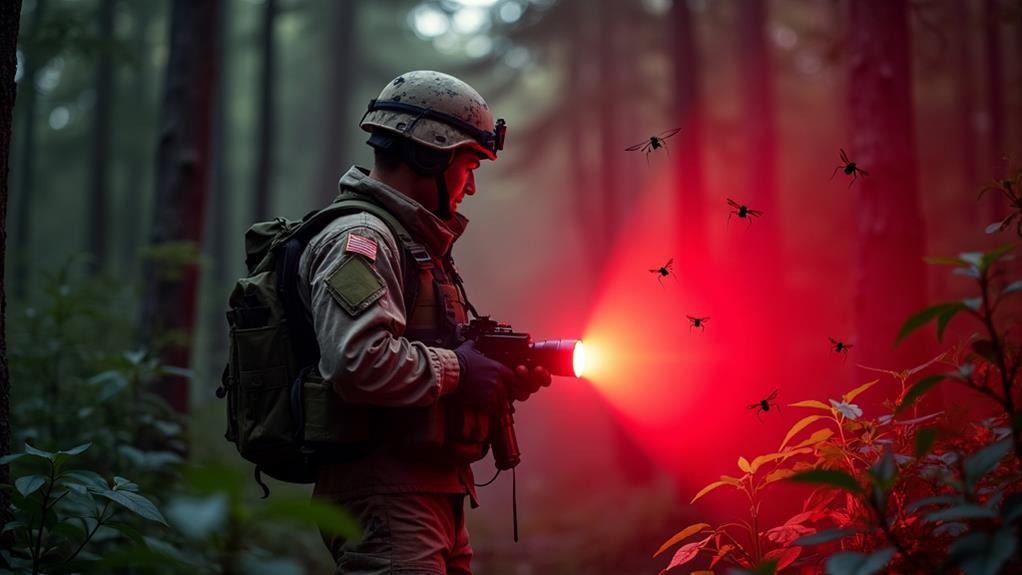
Ever wonder why soldiers prefer red flashlights at night? It's because red light is less visible to insects and wildlife. Unlike white or blue light, which attracts bugs, red light doesn't draw insects in. This allows soldiers to stay focused on their missions without constant distractions from pests.
Additionally, many species of wildlife are less sensitive to red wavelengths. Using red flashlights helps soldiers avoid provoking aggressive reactions or disturbing animals in their natural habitats. This is crucial during stealth operations, where maintaining a low profile is essential. Alerting nearby animals could compromise a mission.
Red flashlights also create a more comfortable environment for soldiers. With fewer bugs around, there's less irritation and fewer bites, allowing military personnel to concentrate on their tasks. In the midst of a mission, every bit of comfort can significantly enhance performance and morale.
Light Pollution Control
Light pollution control is crucial in military operations, with red flashlights playing a key role. During missions, revealing your position can be a critical error. Red light emits less brightness than white or blue light, significantly lowering the risk of detection. This is essential for maintaining operational secrecy and avoiding enemy detection.
Using red light minimizes light pollution in sensitive environments, crucial for covert missions. It provides enough illumination for tasks without drawing attention. Furthermore, it allows effective operations in natural settings, preserving local ecosystems.
Consider these benefits of using red light for light pollution control:
- Operational Secrecy: Red light reduces long-distance visibility, keeping your location concealed.
- Minimal Light Pollution: Supports a low-light environment, vital for stealth operations.
- Environmental Preservation: Less disruptive to wildlife and natural habitats.
Night Vision Equipment Compatibility
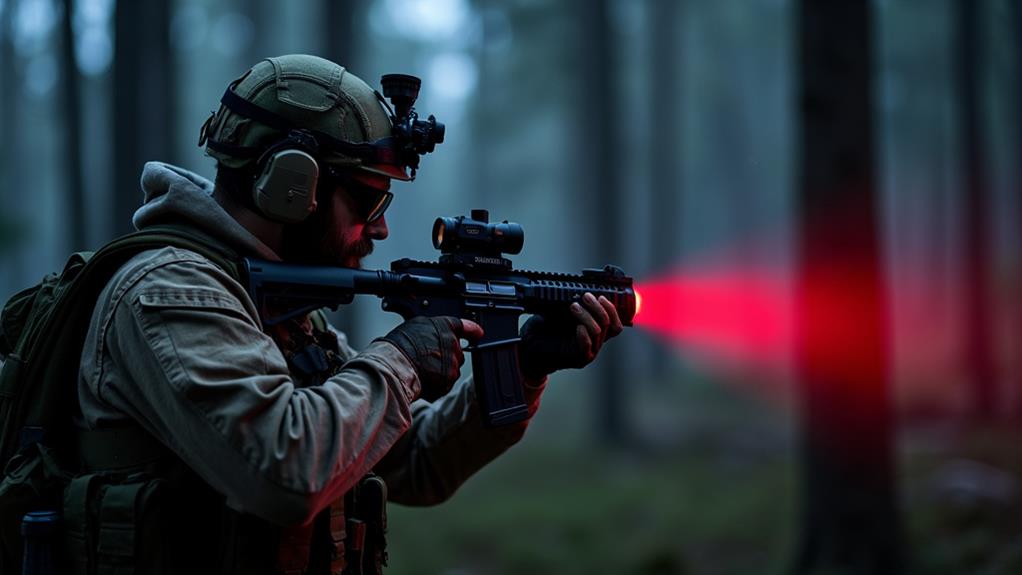
Night vision equipment compatibility is a crucial factor in the military's use of red flashlights. In the field, maintaining the effectiveness of night vision devices is paramount. Red light does not interfere with these devices, ensuring optimal situational awareness in low-light conditions. This compatibility allows seamless transitions between natural vision and enhanced vision provided by night vision tools.
Red wavelengths facilitate quick adaptation to varying light environments without causing glare or flash blindness. This is vital during critical missions where visibility and stealth are essential. Under red light, you can gather intelligence, navigate stealthily, and effectively use various night vision tools, providing a tactical advantage and improving operational readiness.
Using red flashlights ensures that your visibility and the functionality of your night vision equipment remain uncompromised. This enables the military to maintain its edge in the field, ensuring you are always prepared for any situation. In night operations, red light is your ally, helping you stay sharp and undetected.
Glare Reduction
During night operations, red flashlights are essential for reducing glare, thereby enhancing safety and navigation. Blinding light can compromise night vision, but red light minimizes this risk, allowing for confident and precise movement.
Here's why glare reduction is important:
- Reduces flashblindness: Red light's longer wavelengths scatter less in the atmosphere, preventing temporary blindness during critical moments.
- Maintains night vision: Red light preserves night vision adaptations, keeping you aware of your surroundings without overwhelming brightness.
- Enhances task performance: Reduced glare allows better focus on detailed tasks, improving performance and minimizing distractions.
Sleep Pattern Benefits
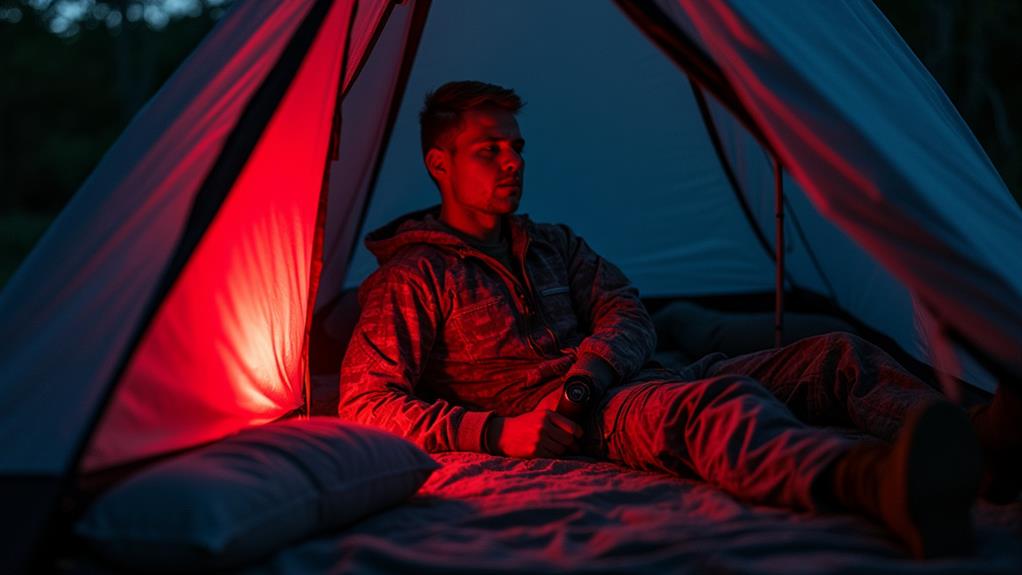
Switching to red flashlights can significantly improve soldiers' sleep patterns after night missions. Red light wavelengths are less disruptive to sleep cycles compared to white or blue light, leading to better sleep quality. Using red lighting can boost melatonin production, a hormone essential for regulating sleep patterns and ensuring adequate rest.
Maintaining natural biological rhythms is crucial in military lighting scenarios. Red lights support this, enhancing overall well-being. After high-stress operations, red light creates a calming atmosphere that aids in relaxation and recovery, benefiting mental health. Using red flashlights at night can reduce sleep disturbances, allowing for more consistent and restorative sleep.
Night vision is another critical factor. Red light helps preserve night vision, enabling soldiers to perform duties effectively without compromising rest. Integrating red lighting into military environments improves operational effectiveness while prioritizing health and well-being, leading to a more resilient and prepared force.

